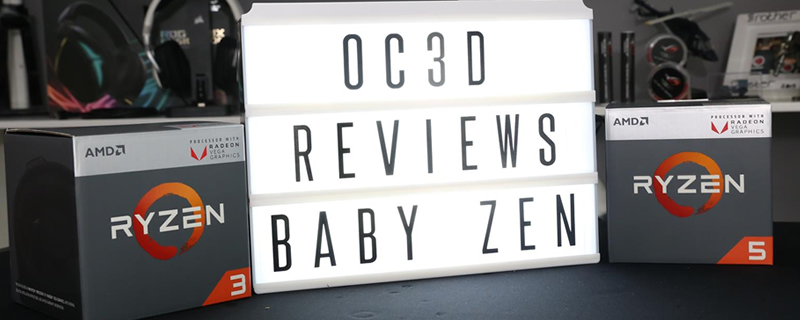AMD Raven Ridge Ryzen 3 2200G and Ryzen 5 2400G Review
Conclusion
The launch of AMD’s Ryzen architecture shook the industry, changing what users expected for their CPUs while driving down the prices of both high-end and low-end processors.Â
This change in the market is highlighted Intel’s response to Ryzen, with their new i7 8700K hex-core processor shipping at the same price as their last-generation quad-core 7700K and their colossal 18-core Skylake-X i9 7980XE which will ship for a similar price to their last-generation 10-core Broadwell-E i7 6950X did at launch. AMD has revolutionised the CPU market.
Raven Ridge brings Ryzen to a new segment of the market, allowing AMD to deliver CPUs to mobile and desktop users who require capable integrated graphics. On the desktop, this adds a lot of value for money over AMD’s existing low-end Ryzen offerings, while also bringing the company further into the OEM PC market.
When compared to their last generation counterparts, the Ryzen 3 2200G and the Ryzen 5 2400G offer more bang for your buck than AMD’s existing Ryzen 3 1200 and Ryzen 5 1400, delivering several design improvements over standard Zen, higher clock speeds and an integrated GPU component. Do these changes come with higher TDPs or prices? No, AMD is shipping these units with the same or similar prices to their last-gen counterparts did at launch, effectively giving users a free iGPU to play with.
On paper, Raven Ridge is a huge design win, though things like reduced L3 cache sizes and only eight PCIe lanes are something that many of you may be concerned about. Don’t be; if you look at our tests, you will see that in every benchmark we have AMD has outperformed their last-generation models, sometimes to a shocking degree. While the low number of PCIe lanes may be a sticking point for some, Raven Ridge still offers enough for a GPU as well as four separate lanes to use with an NVMe SSD. This is enough for the vast majority of users, anyone who needs more should invest in a higher-end CPU/platform.    Â
On the GPU side, AMD offers a compelling integrated graphics setup, something that is more than enough for basic gaming needs. The 2400G offers a similar number of GPU TFLOPs to a standard Xbox One, making it a capable graphics unit, though like the Xbox One this means that you will need to aim for lower quality graphical settings or a sub-1080p resolution to play a lot of modern titles. The gaming capabilities of these APUs is something that we plan to take a more in-depth look at in the future. Â
When overclocking both APUs, we found that both units were able to clock up to 4GHz with relative ease, though neither were stable at higher clocks, exhibiting the same overclocking limits as AMD’s other existing Ryzen processors. Even so, both units are touted as offering support for increased memory clock speeds, with both products supporting 3200MHz memory out of the box with no voltage tweaks.
The GPU portion of this product is also ready to overclock, potentially opening up more gaming performance, though sadly we have not investigated this in our limited review timeframe. iGPU overclocking is something that we may look into at a later date.Â
Our only real grievance with the Ryzen 3 2200G and Ryzen 5 2400G is their potential to get quite hot under load with AMD’s stock cooling solution, with the 2400G reaching temperatures of 85 degrees under stress testing under OCCT. These thermals are very close to the processors 95-degree thermal limit. While most users of this product are unlikely to place their CPU under such extreme pressure, this is a problem that is worth mentioning. It almost goes without saying that overclockers should invest in an aftermarket cooler for this APU. Â
In short, both the Ryzen 3 2200G and the Ryzen 5 2400G offer a lot of value for money, outperforming their last-generation counterparts with the same launch prices while also offering improved DDR4 memory support and a capable integrated Vega GPU. While the built-in graphics here are lower end than an AMD RX 460, they are stronger than any other AMD APU to date and will easily surpass anything that Intel’s iGPUs currently offer in games. Â
If you already own a dedicated GPU, arguments can be made for a move to a CPU like the Ryzen 5 1600 on the AM4 platform. The Ryzen 5 1600 offers six-cores and 12-threads for around £20 more than the Ryzen 5 2400G, great value if you already own a GPU and are willing to make up the single-threaded performance gap with overclocking. If you also need a new GPU, the cost gap widens significantly, showcasing what Raven Ridge offers in today’s market, a decently powerful CPU + GPU solution. Â
If there is one thing that AMD’s Raven Ridge APUs scream, its value. Both products deliver PC builders higher clock speeds, integrated Vega graphics and a range of product design improvements while maintaining similar pricing to their original Ryzen 3 1200 and Ryzen 5 1400 series CPUs, providing a lot amount of extra performance and new capabilities to the Ryzen desktop lineup. For this reason, both AMD’s Ryzen 3 2200G and Ryzen 5 2400G will be receiving OC3D Value for money awards.Â
You can join the discussion on AMD’s new Raven Ridge Ryzen 3 2200G and Ryzen 5 2400G APUs on the OC3D Forums.Â




